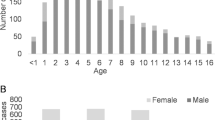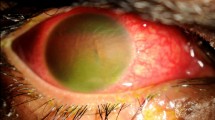Abstract
Objective
To determine the frequency, demography, aetiology and mechanisms of ocular injuries associated with childhood traumatic cataract in Nigeria.
Methods
A retrospective multicentre study conducted across ten child eye health tertiary facilities in Nigeria between January 2017 and December 2021. Clinic records of all children aged 0–17 years who had been diagnosed with cataract at the various participating centres were reviewed. Information collected include: biodata, mechanism of injury; laterality, place of injury; object responsible; person responsible; duration before presentation and surgical intervention.
Results
A total of 636 out of 1656 children (38.4%) had traumatic cataracts during the study period. Their mean age was 109.4 ± 45.2 months with a male-to-female ratio of 2:1. Most injuries were unilateral, two (0.3%) children had bilateral involvement. Only 78 (15.3%) children presented within 4 weeks of the injury. Closed globe injuries were responsible for the traumatic cataract in 475 (74.7%) children, while open globe injuries were more likely to present within 24 h (P < 0.001). The commonest objects of injury were cane, sticks, plant, wood and play materials. Self-inflicted injuries occurred in about 82 (13%) children while 407 (64.0%) were caused by close relatives and contacts. The location where trauma occurred was home in 375 (59.8%) and school in 107 (16.8%) children.
Conclusion
This multicentre study demonstrates that more than one-third of all childhood cataracts in Nigeria are trauma-related and majority are due to closed globe injuries. Public health interventions to reduce the occurrence of ocular trauma and to encourage early presentation after trauma are advocated.
This is a preview of subscription content, access via your institution
Access options
Subscribe to this journal
Receive 18 print issues and online access
$259.00 per year
only $14.39 per issue
Buy this article
- Purchase on Springer Link
- Instant access to full article PDF
Prices may be subject to local taxes which are calculated during checkout
Similar content being viewed by others
Data availability
Data is available upon reasonable request
References
Yardley AM, Hoskin AK, Hanman K, Wan SL, Mackey DA. Animal-inflicted ocular and adnexal injuries in children: a systematic review. Surv Ophthalmol. 2015;60:536–46.
Thylefors B. Epidemiological patterns of ocular trauma. Aust N Z J Ophthalmol. 1992;20:95–8.
Zimmermann A, Magalhaes I, Tanaka H, Zimmermann I, Arieta C. Pediatric traumatic cataract review: origin of the trauma. Rev Bras Oftalmol. 2019;78. https://doi.org/10.5935/0034-7280.20180105.
Kedwany SM, Saleh MGA, Tohamy D, Mostafa MM. Outcome of pediatric traumatic cataract in upper Egypt: a tertiary center study. Clin Ophthalmol. 2021;15:1583–9.
Du Y, He W, Sun X, Lu Y, Zhu X. Traumatic cataract in children in eastern China: Shanghai pediatric cataract study. Sci Rep. 2018;8:2588.
Gurung G, Bajracharya K. Visual outcome of pediatric traumatic cataract in Lumbini Eye Institute, Bhairahawa, Nepal. Nepal J Ophthalmol. 2020;12:17–24.
Nkanga E, Okonkwo S, Ezeh E, Agweye C, Ibanga A, Nkanga D. Paediatric cataracts in a tertiary eye centre in South-South Nigeria: an initial audit of surgical outcome. Niger J Med. 2022;31:521–9.
Khokhar S, Gupta S, Yogi R, Gogia V, Agarwal T. Epidemiology and intermediate-term outcomes of open- and closed-globe injuries in traumatic childhood cataract. Eur J Ophthalmol. 2014;24:124–30.
Olatunbosun MK, Olufisayo A, Adekunle R, Ikuomenisan SJ, Olayinka OA, Onakoya AO. Profile of pediatric cataract seen at Lagos University Teaching Hospital, Southwest Nigeria. Park J Ophthal. 2018;34. https://doi.org/10.36351/pjo.v34i1.20.
Ugalahi MO, Olusanya BA, Aremu OO, Baiyeroju AM. Outcome of surgery for traumatic cataract in children in a child eye health tertiary facility, Ibadan, Nigeria. Ther Adv Ophthalmol. 2021;13:25158414211005308. https://doi.org/10.1177/25158414211005308.
Patel D. Eye injuries: improving our practice. Community Eye Health. 2015;28:41–3.
Seimon R. Preventing blindness from eye injuries through health education. Community Eye Health. 2005;18:106–7.
Randrianotahina HC, Nkumbe HE. Pediatric cataract surgery in Madagascar. Niger J Clin Pr. 2014;17:14–7.
Asferaw M, Mekonen SY, Woodruff G, Gilbert CE, Tesfaye S. Outcome of paediatric cataract surgery in Northwest Ethiopia: a retrospective case series. Br J Ophthalmol. 2019;103:112–8.
Wang P, Fu Q, Yin H, Wang L, Liu L. Paediatric traumatic cataracts in Southwest China: epidemiological profile. BMC Ophthalmol. 2022;22:208.
Günaydın NT, Oral AYA. Pediatric traumatic cataracts: 10-year experience of a tertiary referral center. BMC Ophthalmol. 2022;22:199.
Adlina AR, Chong YJ, Shatriah I. Clinical profile and visual outcome of traumatic paediatric cataract in suburban Malaysia: a ten-year experience. Singap Med J. 2014;55:253–6.
Bothun ED, Repka MX, Dean TW, Gray ME, Lenhart PD, Li Z, et al. Visual outcomes and complications after lensectomy for traumatic cataract in children. JAMA Ophthalmol. 2021;139:647–53.
Doğan E, Çelik E, Gündoğdu K, Alagöz G. Characteristics of pediatric traumatic cataract and factors affecting visual outcomes. Injury. 2023;54:168–72.
Xu YN, Huang YS, Xie LX. Pediatric traumatic cataract and surgery outcomes in eastern China: a hospital-based study. Int J Ophthalmol. 2013;6:160–4.
Shah MA, Shah SM, Gosai SR, Gupta SS, Khanna RR, Patel KB, et al. Comparative study of visual outcome between open- and closed-globe injuries following surgical treatment of traumatic cataract in children. Eur J Ophthalmol. 2018;28:406–11.
Ram J, Verma N, Gupta N, Chaudhary M. Effect of penetrating and blunt ocular trauma on the outcome of traumatic cataract in children in northern India. J Trauma Acute Care Surg. 2012;73:726–30.
Shah M, Shah S, Shah S, Prasad V, Parikh A. Visual recovery and predictors of visual prognosis after managing traumatic cataracts in 555 patients. Indian J Ophthalmol. 2011;59:217–22.
Gradin D, Yorston D. Intraocular lens implantation for traumatic cataract in children in East Africa. J Cataract Refract Surg. 2001;27:2017–25.
Author information
Authors and Affiliations
Contributions
DAP was responsible for designing the study protocol, writing the proposal and report, extracting and analysing data, interpreting results and creating tables. NM was responsible for designing the study protocol, writing the proposal and report, extracting and analysing data and interpreting results. AM extracted and analysed data, interpreted results and provided feedback on the report. PW was responsible for designing the study protocol, writing the proposal and report, extracting and analysing data. IE was responsible for designing the study protocol, writing the proposal and report, extracting and analysing data. KOM was responsible for designing the study protocol, writing the proposal and report, extracting and analysing data and interpreting results. MU, EDN, NU and CNE contributed to data extraction and writing of the report. VWO was responsible for designing the study protocol, writing the proposal and report, extracting and analysing data and interpreting results. OAD, TEP, CRO, NME, AAS and HDM contributed to data extraction and providing feedback for the report. TO and BO also extracted and analysed data, interpreted results and provided feedback on the report.
Corresponding author
Ethics declarations
Competing interests
The authors declare no competing interests.
Additional information
Publisher’s note Springer Nature remains neutral with regard to jurisdictional claims in published maps and institutional affiliations.
Rights and permissions
Springer Nature or its licensor (e.g. a society or other partner) holds exclusive rights to this article under a publishing agreement with the author(s) or other rightsholder(s); author self-archiving of the accepted manuscript version of this article is solely governed by the terms of such publishing agreement and applicable law.
About this article
Cite this article
Ademola-Popoola, D., Muhammad, N., Mayor, A. et al. Childhood traumatic cataract in Nigeria; a multicentre study: 2017–2021. Eye (2023). https://doi.org/10.1038/s41433-023-02749-9
Received:
Revised:
Accepted:
Published:
DOI: https://doi.org/10.1038/s41433-023-02749-9



